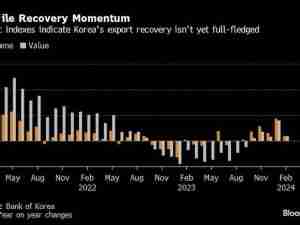The Singapore dollar is vulnerable to retesting a four-month low, with signs that benign inflation and a gradual economic recovery will keep the central bank on hold at its April monetary policy review.
Elevated U.S. Treasury yields have already helped push the greenback through its 100-day moving average versus the city-state’s currency. While momentum stalled at 1.3531, just short of the 200-day moving average, it may just be a matter of time before the level is breached.
Inflation data due this week is forecast to show only the slimmest of gains, which would give little cause for the Monetary Authority of Singapore to tap the brakes on currency declines by adjusting the exchange-rate band it uses to ensure price stability. Unlike most other central banks, the MAS uses the currency as its main monetary tool, rather than interest rates.
“We expect the central bank to maintain the neutral policy,” said Irene Cheung, a currency strategist at Australia & New Zealand Banking Group Ltd. in Singapore. “Inflation is emerging from deflation, but will remain modest.”
Quicktake: Here’s why MAS targets FX, not interest rates
Figures due Tuesday are projected to show core inflation rose just 0.1% in February from a year ago, following negative readings over the previous 12 months.
In its last decision in October, the MAS left policy unchanged, given price changes were gradual and core inflation was expected to remain well below its long-term average. Its next review is due in April.
Cheung estimates that the Singapore dollar is trading slightly above the midpoint of the exchange-rate band, which the MAS doesn’t disclose.
This suggests the currency has scope to weaken, and is consistent with movement in the country’s nominal effective exchange rate versus its major trading partners, which shows the currency in the upper end of its 12-month range.
If the greenback does breach its 200-day moving average versus the Singapore dollar, it could even spark a run back toward resistance at 1.38, a level the pair hasn’t touched that level since late July.
Below are the key Asian economic data and events due this week:
- Monday, March 22: New Zealand 1Q consumer confidence, China 1-and 5-year loan prime rates, South Korea 20-day exports/imports
- Tuesday, March 23: Singapore CPI, New Zealand credit card spending
- Wednesday. March 24: Bank of Thailand policy decision, Japan PMI’s, New Zealand trade balance, South Korea PPI
- Thursday, March 25: Philippines policy decision
- Friday, March 26: Tokyo CPI, China 4Q BoP current account balance, South Korea consumer confidence, Singapore industrial production








